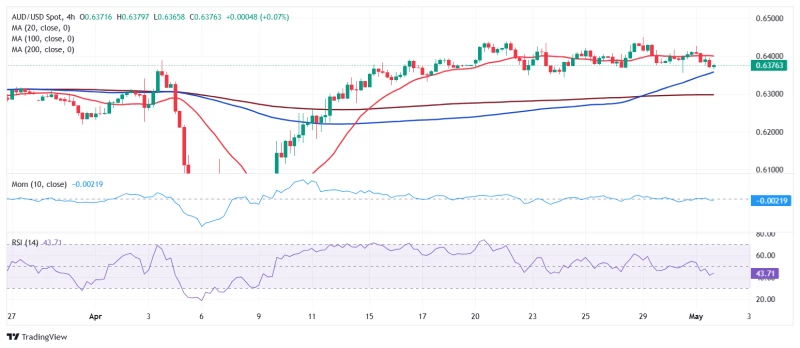The Australian dollar (AUD) retreated against the US dollar, trading near 0.6376 as global trade optimism strengthened the greenback despite positive Australian economic indicators.
AUD (AUD/USD) Under Pressure as US Dollar Demand Rises
The Australian dollar (AUD) fell to a fresh weekly low of 0.6365 on Thursday as demand for the US dollar increased across the board. This decline occurred despite a generally positive tone in global equity markets, highlighting a divergence in the usual risk sentiment correlation. Both stocks and the US dollar gained ground as investors processed encouraging developments regarding potential easing of global trade tensions.
Mexican President Claudia Sheinbaum reported having a "very positive conversation" with US President Donald Trump, stating they would continue working on trade matters in the coming days. President Trump also mentioned that US Treasury Secretary Scott Bessent is actively engaged in negotiations with "200 nations" amid comprehensive trade talks. However, it's worth noting that formal discussions between Washington and Beijing have yet to commence, leaving a significant area of trade uncertainty unresolved.
AUD (AUD/USD) Fails to Capitalize on Strong Australian Trade Data
The Australian currency couldn't gain momentum despite the release of favorable economic data from Australia. The March Trade Balance reported a substantial surplus of 6,900 million, with imports declining by 2.2% while exports rose impressively by 7.6%. These figures demonstrate resilience in Australia's external trade position, but the currency market appeared more focused on broader dollar strength.
In the United States, economic indicators presented a mixed picture. Initial Jobless Claims for the week ended April 26 increased to 241,000, exceeding the forecast of 224,000. Conversely, the April ISM Manufacturing Purchasing Managers' Index (PMI) came in at 48.7, below the 50 threshold, indicating contractio,n but still better than the expected 48.0 and only slightly lower than March's 49.0 reading.
AUD (AUD/USD) Awaits Critical Employment Data and Retail Sales
Market attention now shifts to upcoming economic releases that could influence the AUD/USD pair's trajectory. Australia will publish its Q1 Producer Price Index (PPI) and Retail Sales figures on Friday, providing insight into both inflation pressures and consumer spending patterns.
The United States will release its highly anticipated April Nonfarm Payrolls (NFP) report, with analysts expecting the addition of 130,000 new job positions. The Unemployment Rate is projected to remain steady at 4.2%, unchanged from March. This employment data holds particular significance as it could influence Federal Reserve monetary policy considerations and, consequently, dollar valuation.
AUD (AUD/USD) Technical Analysis Points to Consolidation Phase
From a technical perspective, the AUD/USD pair remains in a consolidative phase near its 2025 high of 0.6450. The immediate support level sits at 0.6342, marking the April 24 low and forming the base of the current trading range. Analysis of the daily chart reveals that AUD/USD encountered resistance around the mildly bearish 200 Simple Moving Average (SMA) currently positioned at 0.6460.
Meanwhile, the 20 and 100 SMAs are converging around the 0.6290 level, potentially providing support if the pair continues to decline. Technical indicators are moving lower while still in positive territory, with the Momentum indicator approaching its 100 line, suggesting diminishing upward momentum but not yet signaling a definitive reversal.
The 4-hour chart indicates AUD/USD is trading below a flat 20 SMA around 0.6400, while the 100 SMA advances below the current level but remains above the 200 SMA, which may limit downward potential. Technical indicators have flattened just below their midlines, not providing clear confirmation of another leg lower but suggesting near-term bearish pressure could persist.
AUD/USD currently appears to be at a critical juncture, with immediate range boundaries at 0.6342 and 0.6450. The upcoming economic data releases from both Australia and the United States will likely determine which boundary is tested next, with the potential to establish a new directional bias for the pair.
Key Levels to Watch for AUD (AUD/USD)
- Current Price: 0.6376
- Weekly Low: 0.6365
- Resistance: 0.6450 (2025 high), 0.6460 (200 SMA)
- Support: 0.6342 (April 24 low), 0.6290 (20 & 100 SMA convergence)
Market participants will closely monitor how AUD/USD responds to these technical levels alongside the forthcoming economic data releases, particularly the US employment report which carries significant market-moving potential.

 Peter Smith
Peter Smith

 Peter Smith
Peter Smith


